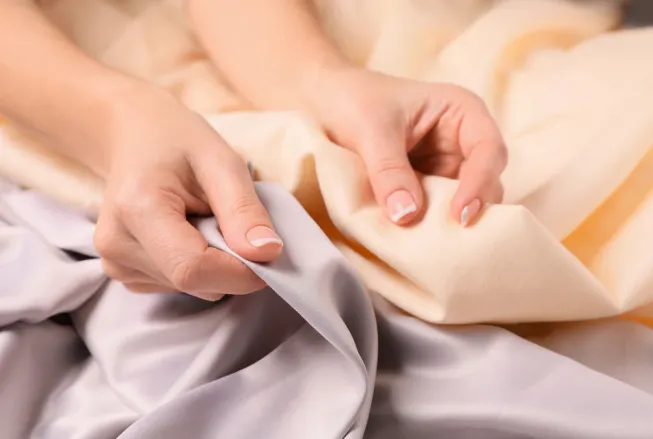Last updated on July 20th, 2025 at 04:28 am
Have you noticed that whenever you go to the market, you’ll most probably see both Egyptian cotton and Pima cotton as options in the premium category? Yes, you will mostly see both of them. Why? This is because both fabrics are known for comfort and durability, but how are they actually different? This guide explains the major differences between Egyptian and Pima cotton sheets so you can choose wisely for your next bedding purchase.
Origins and Growing Conditions
Egyptian cotton’s home is, without a doubt, in the Nile River Valley region of Egypt. The climate in this area is exceptional for the growth of cotton with fiber lengths unparalleled anywhere else in the world. The hot days, cool nights, accompanied by nutrient-rich soil, help develop cotton plants that give out some of the finest fibers in the world. Pima cotton bears its own unique history as well, it has its own fascinating background also. It is primarily grown in the states of Arizona, California, New Mexico, and Texas. The American Southwest has very harsh weather, but its long growing seasons have a lot of potential, similar to Egypt’s Nile Valley, where fibers produced are at peak quality. Most of the Pima cotton is grown in the United States, but it is also cultivated in Peru and Australia, which have the same climate conditions. The geographic distinction matters because the specific environment where cotton grows has a direct impact on fabric quality. The growing conditions for both Egyptian and Pima cotton are optimal, resulting in far better fibers than standard varieties of cotton available elsewhere.
Fiber Quality and Thread Count
The main difference in the technical aspects of Egyptian cotton and Pima cotton is primarily the fiber structure. They both belong to the categorization of extra-long staple (ELS), which means they produce a certain grade of fibers external to standard cotton variations. Fibers of Egyptian Cotton are around 1.4 to 1.6 inches in length while Pima Cotton fibers are roughly between 1.4 to 1.5 inches long. These advantages also have some benefits. First, stronger and finer yarns can be spun from them. Second, these yarns have fewer exposed fiber ends throughout the fabric, making it smoother against the skin. Third, the longevity of cotton sheets made from long fibers helps maintain their quality after multiple washes. Marketing big claims about the thread count has led to this measurement receiving plenty of attention. While the estimating figures boast higher thread counts for their sheets, which at times go over 1000, this figure alone doesn’t decide quality. Usage of high-quality big fibers leads to, more than extremely high thread counts with shorter woven cotton fibers. Moderately high thread counts between 400-600 produced milled with advanced threaded fibers are better than outranges threaded with smaller, weaker strands. The threads of the milled sheets are usually between 200 and 700. For either Egyptian or Pima cotton, the optimum level of comfort is usually between 400 and 600 threads per inch. This is dense enough to ensure comfort and softness while maintaining breathability.
Texture and Feel
The most important step for most customers is the comforting feeling experienced while sleeping on 100% cotton sheets. Let’s see how it relates to both materials. Egyptian cotton has a soft feel, but it is also heavy. When placed on the mattress, it usually sits nicely on it. They get softer with each wash, while maintaining their structural integrity. In the case of Pima cotton, it is considered similarly soft but differs in texture. It is believed that Pima has a more silky, shiny feel than the crisp smoothness of Egyptian cotton. Pima sheets are also known to be slightly lighter while upholding their superb strength. Both fabrics can circulate air very effectively, which aids in temperature control for the body during the night. However, different weaving styles (percale, sateen, twill, etc) do change the overall feeling of the sheet regardless of whether it is made of Egyptian cotton or Pima cotton.
Durability and Longevity
When it comes to investing in sheets made from premium cotton, the investment makes the most sense when taking into account the lifespan of the sheets. The same is true for Egyptian and Pima cotton sheets because they last much longer than standard cotton sheets. These sheets endure years of use and hundreds of washes because of stronger fabric made from longer fibers that resist pilling, tearing, and fading. Egyptian cotton sheets outlast standard cotton sheets because of their slight advantages with longevity. They tend to last around 30% longer than their counterparts. With the right care, high-quality Egyptian cotton bedsheets can last over a decade. The same can be said for Pima cotton bedsheets which are known to last seven to eight years. Finally, the manufacturing process affects how durable the sheets are. Single-ply construction using longer fibers makes them stronger than multi-ply construction that uses shorter fibers. So, when comparing Egyptian and Pima cotton sheets, consider whether they use single or multi-ply construction.
Conclusion
In the case of choosing between Egyptian and Pima cotton sheets, keep in mind your preferences in terms of texture, weight, and budget. Both choices are far more durable and comfortable than ordinary cotton options. For those looking to indulge in premium bedding with an exceptional weight and longevity, Egyptian cotton sheets are what you want, as they represent the gold standard. Pure Parima only sources extra-long staple Egyptian cotton, which ensures the claims made regarding the sheets are indeed worth the investment. Meanwhile, those who wish for a softer feel and lower prices will find Pima cotton to be a more affordable alternative, lacking some quality. Regardless of which option you choose, it goes without saying that the investment will reward you with unparalleled sleep comfort for many years to come.

